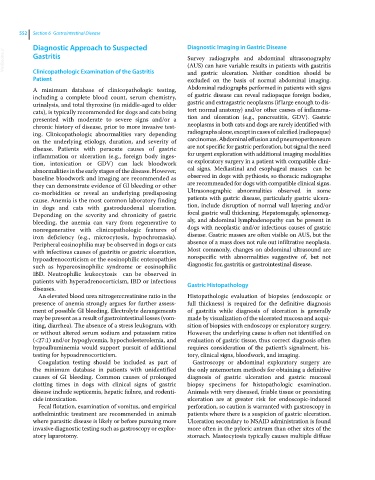Page 584 - Clinical Small Animal Internal Medicine
P. 584
552 Section 6 Gastrointestinal Disease
Diagnostic Approach to Suspected Diagnostic Imaging in Gastric Disease
VetBooks.ir Gastritis Survey radiographs and abdominal ultrasonography
(AUS) can have variable results in patients with gastritis
Clinicopathologic Examination of the Gastritis
Patient and gastric ulceration. Neither condition should be
excluded on the basis of normal abdominal imaging.
A minimum database of clinicopathologic testing, Abdominal radiographs performed in patients with signs
including a complete blood count, serum chemistry, of gastric disease can reveal radiopaque foreign bodies,
urinalysis, and total thyroxine (in middle‐aged to older gastric and extragastric neoplasms (if large enough to dis-
cats), is typically recommended for dogs and cats being tort normal anatomy) and/or other causes of inflamma-
presented with moderate to severe signs and/or a tion and ulceration (e.g., pancreatitis, GDV). Gastric
chronic history of disease, prior to more invasive test- neoplasms in both cats and dogs are rarely identified with
ing. Clinicopathologic abnormalities vary depending radiographs alone, except in cases of calcified ( radiopaque)
on the underlying etiology, duration, and severity of carcinomas. Abdominal effusion and pneumoperitoneum
disease. Patients with peracute causes of gastric are not specific for gastric perforation, but signal the need
inflammation or ulceration (e.g., foreign body inges- for urgent exploration with additional imaging modalities
tion, intoxication or GDV) can lack bloodwork or exploratory surgery in a patient with compatible clini-
abnormalities in the early stages of the disease. However, cal signs. Mediastinal and esophageal masses can be
baseline bloodwork and imaging are recommended as observed in dogs with pythiosis, so thoracic radiographs
they can demonstrate evidence of GI bleeding or other are recommended for dogs with compatible clinical signs.
co‐morbidities or reveal an underlying predisposing Ultrasonographic abnormalities observed in some
cause. Anemia is the most common laboratory finding patients with gastric disease, particularly gastric ulcera-
in dogs and cats with gastroduodenal ulceration. tion, include disruption of normal wall layering and/or
Depending on the severity and chronicity of gastric focal gastric wall thickening. Hepatomegaly, splenomeg-
bleeding, the anemia can vary from regenerative to aly, and abdominal lymphadenopathy can be present in
nonregenerative with clinicopathologic features of dogs with neoplastic and/or infectious causes of gastric
iron deficiency (e.g., microcytosis, hypochromasia). disease. Gastric masses are often visible on AUS, but the
Peripheral eosinophilia may be observed in dogs or cats absence of a mass does not rule out infiltrative neoplasia.
with infectious causes of gastritis or gastric ulceration, Most commonly, changes on abdominal ultrasound are
hypoadrenocorticism or the eosinophilic enteropathies nonspecific with abnormalities suggestive of, but not
such as hypereosinophilic syndrome or eosinophilic diagnostic for, gastritis or gastrointestinal disease.
IBD. Neutrophilic leukocytosis can be observed in
patients with hyperadrenocorticism, IBD or infectious Gastric Histopathology
diseases.
An elevated blood urea nitrogen:creatinine ratio in the Histopathologic evaluation of biopsies (endoscopic or
presence of anemia strongly argues for further assess- full thickness) is required for the definitive diagnosis
ment of possible GI bleeding. Electrolyte derangements of gastritis while diagnosis of ulceration is generally
may be present as a result of gastrointestinal losses (vom- made by visualization of the ulcerated mucosa and acqui-
iting, diarrhea). The absence of a stress leukogram, with sition of biopsies with endoscopy or exploratory surgery.
or without altered serum sodium and potassium ratios However, the underlying cause is often not identified on
(<27:1) and/or hypoglycemia, hypocholesterolemia, and evaluation of gastric tissue, thus correct diagnosis often
hypoalbuminemia would support pursuit of additional requires consideration of the patient’s signalment, his-
testing for hypoadrenocorticism. tory, clinical signs, bloodwork, and imaging.
Coagulation testing should be included as part of Gastroscopy or abdominal exploratory surgery are
the minimum database in patients with unidentified the only antemortem methods for obtaining a definitive
causes of GI bleeding. Common causes of prolonged diagnosis of gastric ulceration and gastric mucosal
clotting times in dogs with clinical signs of gastric biopsy specimens for histopathologic examination.
disease include septicemia, hepatic failure, and rodenti- Animals with very diseased, friable tissue or preexisting
cide intoxication. ulceration are at greater risk for endoscopic‐induced
Fecal flotation, examination of vomitus, and empirical perforation, so caution is warranted with gastroscopy in
anthelminthic treatment are recommended in animals patients where there is a suspicion of gastric ulceration.
where parasitic disease is likely or before pursuing more Ulceration secondary to NSAID administration is found
invasive diagnostic testing such as gastroscopy or explor- more often in the pyloric antrum than other sites of the
atory laparotomy. stomach. Mastocytosis typically causes multiple diffuse

